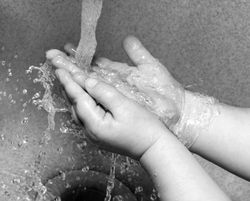APS Hand washing policy
SOAP
Hand sanitizers |
Hand Sanitizers…When to use them and when NOT to use them!
|
Evidence for hand washing in schoolsDid you Know? |
Many studies document handwashing's impact on student and staff attendance.
School-wide handwashing programs reduce absenteeism www.educationworld.com/a_curr/School-Wide-Handwashing-Campaigns-Cut-Germs-Absenteeism.shtml
Effect of hand hygiene on infectious disease risk in the community setting: a meta-analysis. Aiello AE1, Coulborn RM, Perez V, Larson EL. Abstract To quantify the effect of hand-hygiene interventions on rates of gastrointestinal and respiratory illnesses and to identify interventions that provide the greatest efficacy, we searched 4 electronic databases for hand-hygiene trials published from January 1960 through May 2007 and conducted meta-analyses to generate pooled rate ratios across interventions (N=30 studies). Improvements in hand hygiene resulted in reductions in gastrointestinal illness of 31% (95% confidence intervals [CI]=19%, 42%) and reductions in respiratory illness of 21% (95% CI=5%, 34%). The most beneficial intervention was hand-hygiene education with use of nonantibacterial soap. Use of antibacterial soap showed little added benefit compared with use of nonantibacterial soap. Hand hygiene is clearly effective against gastrointestinal and, to a lesser extent, respiratory infections. Studies examining hygiene practices during respiratory illness and interventions targeting aerosol transmission are needed. Lancet. 2005 Jul 16-22;366(9481):225-33. Effect of handwashing on child health: a randomised controlled trial. Luby SP1, Agboatwalla M, Feikin DR, Painter J, Billhimer W, Altaf A, Hoekstra RM. Abstract BACKGROUND: More than 3.5 million children aged less than 5 years die from diarrhoea and acute lower respiratory-tract infection every year. We undertook a randomised controlled trial to assess the effect of handwashing promotion with soap on the incidence of acute respiratory infection, impetigo, and diarrhoea. METHODS: In adjoining squatter settlements in Karachi, Pakistan, we randomly assigned 25 neighbourhoods to handwashing promotion; 11 neighbourhoods (306 households) were randomised as controls. In neighbourhoods with handwashing promotion, 300 households each were assigned to antibacterial soap containing 1.2% triclocarban and to plain soap. Fieldworkers visited households weekly for 1 year to encourage handwashing by residents in soap households and to record symptoms in all households. Primary study outcomes were diarrhoea, impetigo, and acute respiratory-tract infections (ie, the number of new episodes of illness per person-weeks at risk). Pneumonia was defined according to the WHO clinical case definition. Analysis was by intention to treat. FINDINGS: Children younger than 5 years in households that received plain soap and handwashing promotion had a 50% lower incidence of pneumonia than controls (95% CI (-65% to -34%). Also compared with controls, children younger than 15 years in households with plain soap had a 53% lower incidence of diarrhoea (-65% to -41%) and a 34% lower incidence of impetigo (-52% to -16%). Incidence of disease did not differ significantly between households given plain soap compared with those given antibacterial soap. INTERPRETATION: Handwashing with soap prevents the two clinical syndromes that cause the largest number of childhood deaths globally-namely, diarrhoea and acute lower respiratory infections. Handwashing with daily bathing also prevents impetigo. |
The APS School Health Advisory Board (SHAB), in conjunction with its Environmental Health and Asthma Subcommittee (EHAS), worked on the APS handwashing policy in 2015. Most of the information on this page comes from the Policy Implementation Procedure (PIP), which can be found in its entirety at bit.ly/APS-WellnessPIP2017, page 5. We invite comments or questions, which can be sent through the "Contact Us" page.

